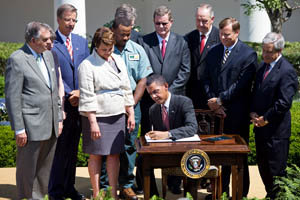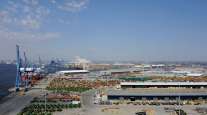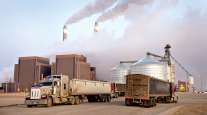Obama Signs Order to Boost Trucks’ Fuel Economy

Editor’s Note: This story has expanded information from an earlier version and contains additional industry and government reaction to Friday’s presidential announcement on truck fuel-efficiency regulations.
Flanked by truck manufacturers and trucking industry executives, President Obama signed a first-of-its-kind order Friday clearing the way for medium- and heavy-duty trucks to meet more stringent fuel-economy targets.
Under the order, the Department of Transportation and Environmental Protection Agency are charged with collaborating on a rule setting limits on the fuel consumed and emissions produced by large commercial vehicles beginning with the 2014 model year.
“Today, we’re going even further, proposing the development of a national standard for medium- and heavy-duty trucks, just as we did for cars and light trucks,” Obama said during the Rose Garden ceremony. “This is the first time we’ll have such a standard.”
The order said that the administration has “the aim of issuing a final rule by July 30, 2011.”
As the government drafts its new rule, it will be required to consider a number of factors including existing strategies and technologies for reducing fuel consumption and “market structure of the trucking industry and the unique demands of heavy-duty vehicle applications.”
Obama said the government believes that “we can increase fuel economy by as much as 25% in tractor trailers using technologies that already exist today.”
“This is going to bring down the costs for transporting goods, serving businesses and consumers alike,” he said. “It will reduce pollution, given that freight vehicles produce roughly one fifth of the greenhouse gas emissions related to transportation.”
Obama said the effort had “broad support.” As a demonstration of that support, American Trucking Associations Chairman Tommy Hodges and the heads of major truck and engine makers were on the presidential platform with him, including Martin Daum of Daimler Trucks North America, Daniel Ustian of Navistar Inc. and Dennis Slagle of Volvo Trucks North America.
Tim Solso, chief executive officer of engine maker Cummins Inc., who also was on the platform, said in a statement following the ceremony that Cummins was “committed to working with regulators, our customers and others in the industry to achieve these important environmental improvements.”
“Participating in this effort is consistent with measures we already have in place to reduce greenhouse gas emissions from our operations and our products,” Volvo’s Slagle said in a separate statement.
“Three years ago when we started the sustainability task force . . . one of our goals as we did that was that we wanted to have a seat at the table,” ATA’s Hodges said. “We wanted to have a say and because of that early work we will have a seat at the table.”
In a letter to DOT and EPA, Daimler’s Daum said the truck maker “recognizes the benefits” of a national program to reduce heavy-truck emissions. He said Daimler “fully supports the adoption of a . . . national program, and welcome the opportunity to be a partner in advancing that goal.”
In addition to the new medium- and heavy-duty standards, Obama also announced that the agencies would “start developing right now a new and higher standard to take effect beginning 2017” for cars and light trucks. Last year, the administration announced new standards that would take effect in 2016.
Beyond the fuel standards, Obama said the administration would “work with public and private sectors to develop the advanced infrastructure that will be necessary for plug-in hybrids and electric vehicles. And we’re going to continue to work to diversify our fuel mix, including biofuels, natural gas, and other cleaner sources of energy.”
“I believe that it’s possible, in the next 20 years, for vehicles to use half the fuel and produce half the pollution that they do today,” he said. “But that’s only going to happen if we are willing to do what’s necessary for the sake of our economy, our security, and our environment.”
In a separate announcement, Canadian Environmental Minister Jim Prentice said that Canada would also be setting emissions standards for heavy vehicles.
“Canada and the United States had great success in establishing common standards for regulating greenhouse gas emissions from passenger automobiles and light trucks,” Prentice said in a statement. “Building on our strong working relationship with the Obama administration, we are taking the next logical step by addressing emissions from heavy-duty vehicles.”
Environment Canada said that it would have a draft of its rules available in the fall of 2010.
Stephen Laskowski, senior vice president of the Canadian Trucking Alliance, said that the group hoped that the announcement would “lead to technology, regulatory and taxation reforms that will help eliminate the fuel efficiencies lost by heavy trucks over the last few years because of federal smog control regulations.”
“Fuel is either the first or second leading cost for a trucking company,” said Laskowski. “So intuitively a regulation designed to reduce this cost should be welcomed by our sector, but the devil will be in the details.”




